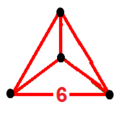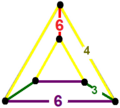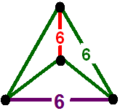Top Qs
Timeline
Chat
Perspective
Paracompact uniform honeycombs
Tessellation of convex uniform polyhedron cells From Wikipedia, the free encyclopedia
Remove ads
In geometry, uniform honeycombs in hyperbolic space are tessellations of convex uniform polyhedron cells. In 3-dimensional hyperbolic space there are 23 Coxeter group families of paracompact uniform honeycombs, generated as Wythoff constructions, and represented by ring permutations of the Coxeter diagrams for each family. These families can produce uniform honeycombs with infinite or unbounded facets or vertex figure, including ideal vertices at infinity, similar to the hyperbolic uniform tilings in two dimensions.
 {3,3,6} |
 {6,3,3} |
 {4,3,6} |
 {6,3,4} |
 {5,3,6} |
 {6,3,5} |
 {6,3,6} |
 {3,6,3} |
 {4,4,3} |
 {3,4,4} |
 {4,4,4} |
Remove ads
Regular paracompact honeycombs
Summarize
Perspective
Of the uniform paracompact H3 honeycombs, 11 are regular, meaning that their group of symmetries acts transitively on their flags. These have Schläfli symbol {3,3,6}, {6,3,3}, {3,4,4}, {4,4,3}, {3,6,3}, {4,3,6}, {6,3,4}, {4,4,4}, {5,3,6}, {6,3,5}, and {6,3,6}, and are shown below. Four have finite Ideal polyhedral cells: {3,3,6}, {4,3,6}, {3,4,4}, and {5,3,6}.
More information 11 paracompact regular honeycombs ...
| 11 paracompact regular honeycombs | |||||||||||
|---|---|---|---|---|---|---|---|---|---|---|---|
 {6,3,3} |
 {6,3,4} |
 {6,3,5} |
 {6,3,6} |
 {4,4,3} |
 {4,4,4} | ||||||
 {3,3,6} |
 {4,3,6} |
 {5,3,6} |
 {3,6,3} |
 {3,4,4} | |||||||
Close
More information Name, SchläfliSymbol {p,q,r} ...
| Name | Schläfli Symbol {p,q,r} |
Coxeter |
Cell type {p,q} |
Face type {p} |
Edge figure {r} |
Vertex figure {q,r} |
Dual | Coxeter group |
|---|---|---|---|---|---|---|---|---|
| Order-6 tetrahedral honeycomb | {3,3,6} | {3,3} | {3} | {6} | {3,6} | {6,3,3} | [6,3,3] | |
| Hexagonal tiling honeycomb | {6,3,3} | {6,3} | {6} | {3} | {3,3} | {3,3,6} | ||
| Order-4 octahedral honeycomb | {3,4,4} | {3,4} | {3} | {4} | {4,4} | {4,4,3} | [4,4,3] | |
| Square tiling honeycomb | {4,4,3} | {4,4} | {4} | {3} | {4,3} | {3,4,4} | ||
| Triangular tiling honeycomb | {3,6,3} | {3,6} | {3} | {3} | {6,3} | Self-dual | [3,6,3] | |
| Order-6 cubic honeycomb | {4,3,6} | {4,3} | {4} | {4} | {3,6} | {6,3,4} | [6,3,4] | |
| Order-4 hexagonal tiling honeycomb | {6,3,4} | {6,3} | {6} | {4} | {3,4} | {4,3,6} | ||
| Order-4 square tiling honeycomb | {4,4,4} | {4,4} | {4} | {4} | {4,4} | Self-dual | [4,4,4] | |
| Order-6 dodecahedral honeycomb | {5,3,6} | {5,3} | {5} | {5} | {3,6} | {6,3,5} | [6,3,5] | |
| Order-5 hexagonal tiling honeycomb | {6,3,5} | {6,3} | {6} | {5} | {3,5} | {5,3,6} | ||
| Order-6 hexagonal tiling honeycomb | {6,3,6} | {6,3} | {6} | {6} | {3,6} | Self-dual | [6,3,6] |
Close
Remove ads
Coxeter groups of paracompact uniform honeycombs
Summarize
Perspective
 |
 |
| These graphs show subgroup relations of paracompact hyperbolic Coxeter groups. Order 2 subgroups represent bisecting a Goursat tetrahedron with a plane of mirror symmetry. | |
This is a complete enumeration of the 151 unique Wythoffian paracompact uniform honeycombs generated from tetrahedral fundamental domains (rank 4 paracompact coxeter groups). The honeycombs are indexed here for cross-referencing duplicate forms, with brackets around the nonprimary constructions.
The alternations are listed, but are either repeats or don't generate uniform solutions. Single-hole alternations represent a mirror removal operation. If an end-node is removed, another simplex (tetrahedral) family is generated. If a hole has two branches, a Vinberg polytope is generated, although only Vinberg polytope with mirror symmetry are related to the simplex groups, and their uniform honeycombs have not been systematically explored. These nonsimplectic (pyramidal) Coxeter groups are not enumerated on this page, except as special cases of half groups of the tetrahedral ones. Seven uniform honeycombs that arise here as alternations have been numbered 152 to 158, after the 151 Wythoffian forms not requiring alternation for their construction.
More information Coxeter group, Simplex volume ...
| Coxeter group | Simplex volume |
Commutator subgroup | Unique honeycomb count | |
|---|---|---|---|---|
| [6,3,3] | 0.0422892336 | [1+,6,(3,3)+] = [3,3[3]]+ | 15 | |
| [4,4,3] | 0.0763304662 | [1+,4,1+,4,3+] | 15 | |
| [3,3[3]] | 0.0845784672 | [3,3[3]]+ | 4 | |
| [6,3,4] | 0.1057230840 | [1+,6,3+,4,1+] = [3[]x[]]+ | 15 | |
| [3,41,1] | 0.1526609324 | [3+,41+,1+] | 4 | |
| [3,6,3] | 0.1691569344 | [3+,6,3+] | 8 | |
| [6,3,5] | 0.1715016613 | [1+,6,(3,5)+] = [5,3[3]]+ | 15 | |
| [6,31,1] | 0.2114461680 | [1+,6,(31,1)+] = [3[]x[]]+ | 4 | |
| [4,3[3]] | 0.2114461680 | [1+,4,3[3]]+ = [3[]x[]]+ | 4 | |
| [4,4,4] | 0.2289913985 | [4+,4+,4+]+ | 6 | |
| [6,3,6] | 0.2537354016 | [1+,6,3+,6,1+] = [3[3,3]]+ | 8 | |
| [(4,4,3,3)] | 0.3053218647 | [(4,1+,4,(3,3)+)] | 4 | |
| [5,3[3]] | 0.3430033226 | [5,3[3]]+ | 4 | |
| [(6,3,3,3)] | 0.3641071004 | [(6,3,3,3)]+ | 9 | |
| [3[]x[]] | 0.4228923360 | [3[]x[]]+ | 1 | |
| [41,1,1] | 0.4579827971 | [1+,41+,1+,1+] | 0 | |
| [6,3[3]] | 0.5074708032 | [1+,6,3[3]] = [3[3,3]]+ | 2 | |
| [(6,3,4,3)] | 0.5258402692 | [(6,3+,4,3+)] | 9 | |
| [(4,4,4,3)] | 0.5562821156 | [(4,1+,4,1+,4,3+)] | 9 | |
| [(6,3,5,3)] | 0.6729858045 | [(6,3,5,3)]+ | 9 | |
| [(6,3,6,3)] | 0.8457846720 | [(6,3+,6,3+)] | 5 | |
| [(4,4,4,4)] | 0.9159655942 | [(4+,4+,4+,4+)] | 1 | |
| [3[3,3]] | 1.014916064 | [3[3,3]]+ | 0 | |
Close
The complete list of nonsimplectic (non-tetrahedral) paracompact Coxeter groups was published by P. Tumarkin in 2003.[1] The smallest paracompact form in H3 can be represented by ![]()
![]()
![]()
![]()
![]()
![]()
![]()
![]()
![]() or
or ![]()
![]()
![]()
![]()
![]() , or [∞,3,3,∞] which can be constructed by a mirror removal of paracompact hyperbolic group [3,4,4] as [3,4,1+,4] :
, or [∞,3,3,∞] which can be constructed by a mirror removal of paracompact hyperbolic group [3,4,4] as [3,4,1+,4] : ![]()
![]()
![]()
![]()
![]()
![]()
![]() =
= ![]()
![]()
![]()
![]()
![]() . The doubled fundamental domain changes from a tetrahedron into a quadrilateral pyramid. Another pyramid is
. The doubled fundamental domain changes from a tetrahedron into a quadrilateral pyramid. Another pyramid is ![]()
![]()
![]()
![]()
![]()
![]()
![]()
![]()
![]() or
or ![]()
![]()
![]()
![]()
![]() , constructed as [4,4,1+,4] = [∞,4,4,∞] :
, constructed as [4,4,1+,4] = [∞,4,4,∞] : ![]()
![]()
![]()
![]()
![]()
![]()
![]() =
= ![]()
![]()
![]()
![]()
![]() .
.
Removing a mirror from some of the cyclic hyperbolic Coxeter graphs become bow-tie graphs: [(3,3,4,1+,4)] = [((3,∞,3)),((3,∞,3))] or ![]()
![]()
![]()
![]()
![]() , [(3,4,4,1+,4)] = [((4,∞,3)),((3,∞,4))] or
, [(3,4,4,1+,4)] = [((4,∞,3)),((3,∞,4))] or ![]()
![]()
![]()
![]()
![]() , [(4,4,4,1+,4)] = [((4,∞,4)),((4,∞,4))] or
, [(4,4,4,1+,4)] = [((4,∞,4)),((4,∞,4))] or ![]()
![]()
![]()
![]()
![]() .
. ![]()
![]()
![]()
![]()
![]()
![]() =
= ![]()
![]()
![]()
![]()
![]()
![]()
![]() ,
, ![]()
![]()
![]()
![]()
![]()
![]() =
= ![]()
![]()
![]()
![]()
![]()
![]()
![]() ,
, ![]()
![]()
![]()
![]()
![]()
![]() =
= ![]()
![]()
![]()
![]()
![]()
![]()
![]() .
.
Another nonsimplectic half groups is ![]()
![]()
![]()
![]()
![]() ↔
↔ ![]()
![]()
![]()
![]()
![]()
![]()
![]() .
.
A radical nonsimplectic subgroup is ![]()
![]()
![]()
![]()
![]() ↔
↔ ![]()
![]()
![]()
![]()
![]()
![]()
![]() , which can be doubled into a triangular prism domain as
, which can be doubled into a triangular prism domain as ![]()
![]()
![]()
![]()
![]()
![]()
![]() ↔
↔ ![]()
![]()
![]()
![]()
![]()
![]() .
.
More information Dimension, Rank ...
| Dimension | Rank | Graphs |
|---|---|---|
| H3 | 5 |
|
Close
Remove ads
Linear graphs
Summarize
Perspective
[6,3,3] family
More information #, Honeycomb name Coxeter diagram: Schläfli symbol ...
Close
More information #, Honeycomb name Coxeter diagram: Schläfli symbol ...
| # | Honeycomb name Coxeter diagram: Schläfli symbol |
Cells by location (and count around each vertex) |
Vertex figure | Picture | ||||
|---|---|---|---|---|---|---|---|---|
| 1 |
2 |
3 |
4 |
Alt | ||||
| [137] | alternated hexagonal (ahexah) ( |
- | - | (4) (3.3.3.3.3.3) |
(4) (3.3.3) |
(3.6.6) |
||
| [138] | cantic hexagonal (tahexah) |
(1) (3.3.3.3) |
- | (2) (3.6.3.6) |
(2) (3.6.6) |
 |
||
| [139] | runcic hexagonal (birahexah) |
(1) (4.4.4) |
(1) (4.4.3) |
(1) (3.3.3.3.3.3) |
(3) (3.4.3.4) |
 |
||
| [140] | runcicantic hexagonal (bitahexah) |
(1) (3.6.6) |
(1) (4.4.3) |
(1) (3.6.3.6) |
(2) (4.6.6) |
 |
||
| Nonuniform | snub rectified order-6 tetrahedral sr{3,3,6} |
Irr. (3.3.3) |
 |
|||||
| Nonuniform | cantic snub order-6 tetrahedral sr3{3,3,6} |
|||||||
| Nonuniform | omnisnub order-6 tetrahedral ht0,1,2,3{6,3,3} |
Irr. (3.3.3) |
||||||
Close
[6,3,4] family
There are 15 forms, generated by ring permutations of the Coxeter group: [6,3,4] or ![]()
![]()
![]()
![]()
![]()
![]()
![]()
More information #, Name of honeycombCoxeter diagram Schläfli symbol ...
| # | Name of honeycomb Coxeter diagram Schläfli symbol |
Cells by location and count per vertex | Vertex figure | Picture | |||
|---|---|---|---|---|---|---|---|
| 0 |
1 |
2 |
3 | ||||
| 16 | (Regular) order-4 hexagonal (shexah) {6,3,4} |
- | - | - | (8) (6.6.6) |
 (3.3.3.3) |
 |
| 17 | rectified order-4 hexagonal (rishexah) t1{6,3,4} or r{6,3,4} |
(2) (3.3.3.3) |
- | - | (4) (3.6.3.6) |
 (4.4.4) |
 |
| 18 | rectified order-6 cubic (rihach) t1{4,3,6} or r{4,3,6} |
(6) (3.4.3.4) |
- | - | (2) (3.3.3.3.3.3) |
 (6.4.4) |
 |
| 19 | order-6 cubic (hachon) {4,3,6} |
(20) (4.4.4) |
- | - | - | (3.3.3.3.3.3) |
 |
| 20 | truncated order-4 hexagonal (tishexah) t0,1{6,3,4} or t{6,3,4} |
(1) (3.3.3.3) |
- | - | (4) (3.12.12) |
 |
 |
| 21 | bitruncated order-6 cubic (chexah) t1,2{6,3,4} or 2t{6,3,4} |
(2) (4.6.6) |
- | - | (2) (6.6.6) |
 |
 |
| 22 | truncated order-6 cubic (thach) t0,1{4,3,6} or t{4,3,6} |
(6) (3.8.8) |
- | - | (1) (3.3.3.3.3.3) |
 |
 |
| 23 | cantellated order-4 hexagonal (srishexah) t0,2{6,3,4} or rr{6,3,4} |
(1) (3.4.3.4) |
(2) (4.4.4) |
- | (2) (3.4.6.4) |
 |
 |
| 24 | cantellated order-6 cubic (srihach) t0,2{4,3,6} or rr{4,3,6} |
(2) (3.4.4.4) |
- | (2) (4.4.6) |
(1) (3.6.3.6) |
 |
 |
| 25 | runcinated order-6 cubic (sidpichexah) t0,3{6,3,4} |
(1) (4.4.4) |
(3) (4.4.4) |
(3) (4.4.6) |
(1) (6.6.6) |
 |
 |
| 26 | cantitruncated order-4 hexagonal (grishexah) t0,1,2{6,3,4} or tr{6,3,4} |
(1) (4.6.6) |
(1) (4.4.4) |
- | (2) (4.6.12) |
 |
 |
| 27 | cantitruncated order-6 cubic (grihach) t0,1,2{4,3,6} or tr{4,3,6} |
(2) (4.6.8) |
- | (1) (4.4.6) |
(1) (6.6.6) |
 |
 |
| 28 | runcitruncated order-4 hexagonal (prihach) t0,1,3{6,3,4} |
(1) (3.4.4.4) |
(1) (4.4.4) |
(2) (4.4.12) |
(1) (3.12.12) |
 | |
| 29 | runcitruncated order-6 cubic (prishexah) t0,1,3{4,3,6} |
(1) (3.8.8) |
(2) (4.4.8) |
(1) (4.4.6) |
(1) (3.4.6.4) |
 | |
| 30 | omnitruncated order-6 cubic (gidpichexah) t0,1,2,3{6,3,4} |
(1) (4.6.8) |
(1) (4.4.8) |
(1) (4.4.12) |
(1) (4.6.12) |
 |
 |
Close
More information #, Name of honeycombCoxeter diagram Schläfli symbol ...
| # | Name of honeycomb Coxeter diagram Schläfli symbol |
Cells by location and count per vertex | Vertex figure | Picture | ||||
|---|---|---|---|---|---|---|---|---|
| 0 |
1 |
2 |
3 |
Alt | ||||
| [87] | alternated order-6 cubic (ahach) h{4,3,6} |
(3.3.3) |
(3.3.3.3.3.3) |
(3.6.3.6) |
||||
| [88] | cantic order-6 cubic (tachach) h2{4,3,6} |
(2) (3.6.6) |
- | - | (1) (3.6.3.6) |
(2) (6.6.6) |
 |
|
| [89] | runcic order-6 cubic (birachach) h3{4,3,6} |
(1) (3.3.3) |
- | - | (1) (6.6.6) |
(3) (3.4.6.4) |
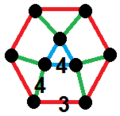 |
|
| [90] | runcicantic order-6 cubic (bitachach) h2,3{4,3,6} |
(1) (3.6.6) |
- | - | (1) (3.12.12) |
(2) (4.6.12) |
 |
|
| [141] | alternated order-4 hexagonal (ashexah) h{6,3,4} |
- | - | (3.3.3.3.3.3) |
(3.3.3.3) |
(4.6.6) |
||
| [142] | cantic order-4 hexagonal (tashexah) h1{6,3,4} |
(1) (3.4.3.4) |
- | (2) (3.6.3.6) |
(2) (4.6.6) |
 |
||
| [143] | runcic order-4 hexagonal (birashexah) h3{6,3,4} |
(1) (4.4.4) |
(1) (4.4.3) |
(1) (3.3.3.3.3.3) |
(3) (3.4.4.4) |
 |
||
| [144] | runcicantic order-4 hexagonal (bitashexah) h2,3{6,3,4} |
(1) (3.8.8) |
(1) (4.4.3) |
(1) (3.6.3.6) |
(2) (4.6.8) |
 |
||
| [151] | quarter order-4 hexagonal (quishexah) q{6,3,4} |
(3) |
(1) |
- | (1) |
(3) |
 |
|
| Nonuniform | bisnub order-6 cubic 2s{4,3,6} |
(3.3.3.3.3) |
- | - | (3.3.3.3.3.3) |
+(3.3.3) |
 |
|
| Nonuniform | runcic bisnub order-6 cubic |
|||||||
| Nonuniform | snub rectified order-6 cubic sr{4,3,6} |
(3.3.3.3.3) |
(3.3.3) |
(3.3.3.3) |
(3.3.3.3.6) |
+(3.3.3) |
||
| Nonuniform | runcic snub rectified order-6 cubic sr3{4,3,6} |
|||||||
| Nonuniform | snub rectified order-4 hexagonal sr{6,3,4} |
(3.3.3.3.3.3) |
(3.3.3) |
- | (3.3.3.3.6) |
+(3.3.3) |
||
| Nonuniform | runcisnub rectified order-4 hexagonal sr3{6,3,4} |
|||||||
| Nonuniform | omnisnub rectified order-6 cubic ht0,1,2,3{6,3,4} |
(3.3.3.3.4) |
(3.3.3.4) |
(3.3.3.6) |
(3.3.3.3.6) |
+(3.3.3) |
||
Close
[6,3,5] family
More information #, Honeycomb nameCoxeter diagram Schläfli symbol ...
Close
More information #, Honeycomb nameCoxeter diagram Schläfli symbol ...
| # | Honeycomb name Coxeter diagram Schläfli symbol |
Cells by location (and count around each vertex) |
Vertex figure | Picture | ||||
|---|---|---|---|---|---|---|---|---|
| 0 |
1 |
2 |
3 |
Alt | ||||
| [145] | alternated order-5 hexagonal (aphexah) h{6,3,5} |
- | - | - | (20) (3)6 |
(12) (3)5 |
(5.6.6) |
|
| [146] | cantic order-5 hexagonal (taphexah) h2{6,3,5} |
(1) (3.5.3.5) |
- | (2) (3.6.3.6) |
(2) (5.6.6) |
 |
||
| [147] | runcic order-5 hexagonal (biraphexah) h3{6,3,5} |
(1) (5.5.5) |
(1) (4.4.3) |
(1) (3.3.3.3.3.3) |
(3) (3.4.5.4) |
 |
||
| [148] | runcicantic order-5 hexagonal (bitaphexah) h2,3{6,3,5} |
(1) (3.10.10) |
(1) (4.4.3) |
(1) (3.6.3.6) |
(2) (4.6.10) |
 |
||
| Nonuniform | snub rectified order-6 dodecahedral sr{5,3,6} |
(3.3.5.3.5) |
- | (3.3.3.3) |
(3.3.3.3.3.3) |
irr. tet |
||
| Nonuniform | omnisnub order-5 hexagonal ht0,1,2,3{6,3,5} |
(3.3.5.3.5) |
(3.3.3.5) |
(3.3.3.6) |
(3.3.6.3.6) |
irr. tet |
||
Close
[6,3,6] family
There are 9 forms, generated by ring permutations of the Coxeter group: [6,3,6] or ![]()
![]()
![]()
![]()
![]()
![]()
![]()
More information #, Name of honeycombCoxeter diagram Schläfli symbol ...
Close
More information #, Name of honeycombCoxeter diagram Schläfli symbol ...
| # | Name of honeycomb Coxeter diagram Schläfli symbol |
Cells by location and count per vertex | Vertex figure | Picture | ||||
|---|---|---|---|---|---|---|---|---|
| 0 |
1 |
2 |
3 |
Alt | ||||
| [47] | rectified order-6 hexagonal (rihihexah) q{6,3,6} = r{6,3,6} |
(2) (3.3.3.3.3.3) |
- | - | (6) (3.6.3.6) |
 (6.4.4) |
 | |
| [54] | triangular (trah) ( h{6,3,6} = {3,6,3} |
- | - | - | (3.3.3.3.3.3) |
(3.3.3.3.3.3) |
{6,3} |
 |
| [55] | cantic order-6 hexagonal (ritrah) ( h2{6,3,6} = r{3,6,3} |
(1) (3.6.3.6) |
- | (2) (6.6.6) |
(2) (3.6.3.6) |
 |
 | |
| [149] | runcic order-6 hexagonal h3{6,3,6} |
(1) (6.6.6) |
(1) (4.4.3) |
(3) (3.4.6.4) |
(1) (3.3.3.3.3.3) |
 |
||
| [150] | runcicantic order-6 hexagonal h2,3{6,3,6} |
(1) (3.12.12) |
(1) (4.4.3) |
(2) (4.6.12) |
(1) (3.6.3.6) |
 |
||
| [137] | alternated hexagonal (ahexah) ( 2s{6,3,6} = h{6,3,3} |
(3.3.3.3.6) |
- | - | (3.3.3.3.6) |
+(3.3.3) |
(3.6.6) |
|
| Nonuniform | snub rectified order-6 hexagonal sr{6,3,6} |
(3.3.3.3.3.3) |
(3.3.3.3) |
- | (3.3.3.3.6) |
+(3.3.3) |
||
| Nonuniform | alternated runcinated order-6 hexagonal ht0,3{6,3,6} |
(3.3.3.3.3.3) |
(3.3.3.3) |
(3.3.3.3) |
(3.3.3.3.3.3) |
+(3.3.3) |
||
| Nonuniform | omnisnub order-6 hexagonal ht0,1,2,3{6,3,6} |
(3.3.3.3.6) |
(3.3.3.6) |
(3.3.3.6) |
(3.3.3.3.6) |
+(3.3.3) |
||
Close
[3,6,3] family
There are 9 forms, generated by ring permutations of the Coxeter group: [3,6,3] or ![]()
![]()
![]()
![]()
![]()
![]()
![]()
More information #, Honeycomb nameCoxeter diagram and Schläfli symbol ...
| # | Honeycomb name Coxeter diagram and Schläfli symbol |
Cell counts/vertex and positions in honeycomb |
Vertex figure | Picture | |||
|---|---|---|---|---|---|---|---|
| 0 |
1 |
2 |
3 | ||||
| 54 | triangular (trah) {3,6,3} |
- | - | - | (∞) {3,6} |
{6,3} |
 |
| 55 | rectified triangular (ritrah) t1{3,6,3} or r{3,6,3} |
(2) (6)3 |
- | - | (3) (3.6)2 |
 (3.4.4) |
 |
| 56 | cantellated triangular (sritrah) t0,2{3,6,3} or rr{3,6,3} |
(1) (3.6)2 |
(2) (4.4.3) |
- | (2) (3.6.4.6) |
 |
 |
| 57 | runcinated triangular (spidditrah) t0,3{3,6,3} |
(1) (3)6 |
(6) (4.4.3) |
(6) (4.4.3) |
(1) (3)6 |
 |
 |
| 58 | bitruncated triangular (ditrah) t1,2{3,6,3} or 2t{3,6,3} |
(2) (3.12.12) |
- | - | (2) (3.12.12) |
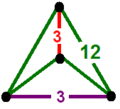 |
 |
| 59 | cantitruncated triangular (gritrah) t0,1,2{3,6,3} or tr{3,6,3} |
(1) (3.12.12) |
(1) (4.4.3) |
- | (2) (4.6.12) |
 |
 |
| 60 | runcitruncated triangular (pritrah) t0,1,3{3,6,3} |
(1) (3.6.4.6) |
(1) (4.4.3) |
(2) (4.4.6) |
(1) (6)3 |
 | |
| 61 | omnitruncated triangular (gipidditrah) t0,1,2,3{3,6,3} |
(1) (4.6.12) |
(1) (4.4.6) |
(1) (4.4.6) |
(1) (4.6.12) |
 |
 |
| [1] | truncated triangular (hexah) t0,1{3,6,3} or t{3,6,3} = {6,3,3} |
(1) (6)3 |
- | - | (3) (6)3 |
 {3,3} |
 |
Close
More information #, Honeycomb nameCoxeter diagram and Schläfli symbol ...
| # | Honeycomb name Coxeter diagram and Schläfli symbol |
Cell counts/vertex and positions in honeycomb |
Vertex figure | Picture | ||||
|---|---|---|---|---|---|---|---|---|
| 0 |
1 |
2 |
3 |
Alt | ||||
| [56] | cantellated triangular (sritrah) s2{3,6,3} |
(1) (3.6)2 |
- | - | (2) (3.6.4.6) |
(3.4.4) |
 |
 |
| [60] | runcitruncated triangular (pritrah) s2,3{3,6,3} |
(1) (6)3 |
- | (1) (4.4.3) |
(1) (3.6.4.6) |
(2) (4.4.6) |
 | |
| [137] | alternated hexagonal (ahexah) ( s{3,6,3} |
(3)6 |
- | - | (3)6 |
+(3)3 |
(3.6.6) |
|
| Scaliform | runcisnub triangular (pristrah) s3{3,6,3} |
r{6,3} |
- | (3.4.4) |
(3)6 |
tricup |
||
| Nonuniform | omnisnub triangular tiling honeycomb (snatrah) ht0,1,2,3{3,6,3} |
(3.3.3.3.6) |
(3)4 |
(3)4 |
(3.3.3.3.6) |
+(3)3 |
||
Close
[4,4,3] family
There are 15 forms, generated by ring permutations of the Coxeter group: [4,4,3] or ![]()
![]()
![]()
![]()
![]()
![]()
![]()
More information #, Honeycomb nameCoxeter diagram and Schläfli symbol ...
| # | Honeycomb name Coxeter diagram and Schläfli symbol |
Cell counts/vertex and positions in honeycomb |
Vertex figure | Picture | |||
|---|---|---|---|---|---|---|---|
| 0 |
1 |
2 |
3 | ||||
| 62 | square (squah) {4,4,3} |
- | - | - | (6) |
 Cube |  |
| 63 | rectified square (risquah) t1{4,4,3} or r{4,4,3} |
(2) |
- | - | (3) |
 Triangular prism |  |
| 64 | rectified order-4 octahedral (rocth) t1{3,4,4} or r{3,4,4} |
(4) |
- | - | (2) |
 |  |
| 65 | order-4 octahedral (octh) {3,4,4} |
(∞) |
- | - | - |  | |
| 66 | truncated square (tisquah) t0,1{4,4,3} or t{4,4,3} |
(1) |
- | - | (3) |
 |  |
| 67 | truncated order-4 octahedral (tocth) t0,1{3,4,4} or t{3,4,4} |
(4) |
- | - | (1) | 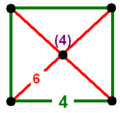 |  |
| 68 | bitruncated square (osquah) t1,2{4,4,3} or 2t{4,4,3} |
(2) |
- | - | (2) |
 |  |
| 69 | cantellated square (srisquah) t0,2{4,4,3} or rr{4,4,3} |
(1) |
(2) |
- | (2) |
 |  |
| 70 | cantellated order-4 octahedral (srocth) t0,2{3,4,4} or rr{3,4,4} |
(2) |
- | (2) |
(1) |
 |  |
| 71 | runcinated square (sidposquah) t0,3{4,4,3} |
(1) |
(3) |
(3) |
(1) |
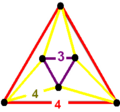 |  |
| 72 | cantitruncated square (grisquah) t0,1,2{4,4,3} or tr{4,4,3} |
(1) |
(1) |
- | (2) |
 |  |
| 73 | cantitruncated order-4 octahedral (grocth) t0,1,2{3,4,4} or tr{3,4,4} |
(2) |
- | (1) |
(1) |
 |  |
| 74 | runcitruncated square (procth) t0,1,3{4,4,3} |
(1) |
(1) |
(2) |
(1) |
 |  |
| 75 | runcitruncated order-4 octahedral (prisquah) t0,1,3{3,4,4} |
(1) |
(2) |
(1) |
(1) |
 |  |
| 76 | omnitruncated square (gidposquah) t0,1,2,3{4,4,3} |
(1) |
(1) |
(1) |
(1) |
 |  |
Close
More information #, Honeycomb nameCoxeter diagram and Schläfli symbol ...
| # | Honeycomb name Coxeter diagram and Schläfli symbol |
Cell counts/vertex and positions in honeycomb |
Vertex figure | Picture | ||||
|---|---|---|---|---|---|---|---|---|
| 0 |
1 |
2 |
3 |
Alt | ||||
| [83] | alternated square h{4,4,3} | - | - | - | (6) | (8) | ||
| [84] | cantic square h2{4,4,3} |
(1) |
- | - | (2) |
(2) |
 |
|
| [85] | runcic square h3{4,4,3} |
(1) |
- | - | (1) |
(4) |
 |
|
| [86] | runcicantic square |
(1) |
- | - | (1) |
(2) |
 |
|
| [153] | alternated rectified square hr{4,4,3} | - | - | {}x{3} | ||||
| 157 | - | - | {}x{6} | |||||
| Scaliform | snub order-4 octahedral s{3,4,4} | - | - | {}v{4} | ||||
| Scaliform | runcisnub order-4 octahedral s3{3,4,4} | cup-4 | ||||||
| 152 | snub square s{4,4,3} | - | - | {3,3} | 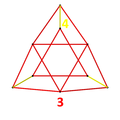 | |||
| Nonuniform | snub rectified order-4 octahedral sr{3,4,4} | - | irr. {3,3} | |||||
| Nonuniform | alternated runcitruncated square ht0,1,3{3,4,4} | irr. {}v{4} | ||||||
| Nonuniform | omnisnub square ht0,1,2,3{4,4,3} | irr. {3,3} | ||||||
Close
[4,4,4] family
There are 9 forms, generated by ring permutations of the Coxeter group: [4,4,4] or ![]()
![]()
![]()
![]()
![]()
![]()
![]() .
.
More information #, Honeycomb nameCoxeter diagram and Schläfli symbol ...
| # | Honeycomb name Coxeter diagram and Schläfli symbol |
Cell counts/vertex and positions in honeycomb |
Symmetry | Vertex figure | Picture | |||
|---|---|---|---|---|---|---|---|---|
| 0 |
1 |
2 |
3 | |||||
| 77 | order-4 square (sisquah) {4,4,4} | - | - | - | [4,4,4] | Cube |  | |
| 78 | truncated order-4 square (tissish) t0,1{4,4,4} or t{4,4,4} | - | - | [4,4,4] |  |  | ||
| 79 | bitruncated order-4 square (dish) t1,2{4,4,4} or 2t{4,4,4} | - | - | [[4,4,4]] | 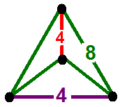 |  | ||
| 80 | runcinated order-4 square (spiddish) t0,3{4,4,4} | [[4,4,4]] |  |  | ||||
| 81 | runcitruncated order-4 square (prissish) t0,1,3{4,4,4} | [4,4,4] |  |  | ||||
| 82 | omnitruncated order-4 square (gipiddish) t0,1,2,3{4,4,4} | [[4,4,4]] |  |  | ||||
| [62] | square (squah) t1{4,4,4} or r{4,4,4} | - | - | [4,4,4] | Square tiling |  | ||
| [63] | rectified square (risquah) t0,2{4,4,4} or rr{4,4,4} | - | [4,4,4] |  |  | |||
| [66] | truncated order-4 square (tisquah) t0,1,2{4,4,4} or tr{4,4,4} | - | [4,4,4] |  |  | |||
Close
More information #, Honeycomb nameCoxeter diagram and Schläfli symbol ...
| # | Honeycomb name Coxeter diagram and Schläfli symbol |
Cell counts/vertex and positions in honeycomb |
Symmetry | Vertex figure | Picture | ||||
|---|---|---|---|---|---|---|---|---|---|
| 0 |
1 |
2 |
3 |
Alt | |||||
| [62] | Square (squah) ( |
(4.4.4.4) |
- | - | (4.4.4.4) |
[1+,4,4,4] =[4,4,4] |
 |
 | |
| [63] | rectified square (risquah) s2{4,4,4} | - | [4+,4,4] |  |  | ||||
| [77] | order-4 square (sisquah) | - | - | - | [1+,4,4,4] =[4,4,4] | Cube |  | ||
| [78] | truncated order-4 square (tissish) |
(4.8.8) |
- | (4.8.8) |
- | (4.4.4.4) |
[1+,4,4,4] =[4,4,4] |
 |
 |
| [79] | bitruncated order-4 square (dish) |
(4.8.8) |
- | - | (4.8.8) |
(4.8.8) |
[1+,4,4,4] =[4,4,4] |
 |
 |
| [81] | runcitruncated order-4 square tiling (prissish) s2,3{4,4,4} | [4,4,4] |  |  | |||||
| [83] | alternated square ( hr{4,4,4} | - | - | [4,1+,4,4] | (4.3.4.3) | ||||
| [104] | quarter order-4 square q{4,4,4} |
[[1+,4,4,4,1+]] =[[4[4]]] | 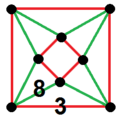 | ||||||
| 153 | alternated rectified square tiling ↔ hrr{4,4,4} | - | [((2+,4,4)),4] | ||||||
| 154 | alternated runcinated order-4 square tiling ht0,3{4,4,4} | [[(4,4,4,2+)]] |  | ||||||
| Scaliform | snub order-4 square tiling s{4,4,4} | - | - | [4+,4,4] | |||||
| Nonuniform | runcic snub order-4 square tiling s3{4,4,4} | [4+,4,4] | |||||||
| Nonuniform | bisnub order-4 square tiling 2s{4,4,4} | - | - | [[4,4+,4]] |  | ||||
| [152] | snub square tiling sr{4,4,4} | - | [(4,4)+,4] |  | |||||
| Nonuniform | alternated runcitruncated order-4 square tiling ht0,1,3{4,4,4} | [((2,4)+,4,4)] | |||||||
| Nonuniform | omnisnub order-4 square tiling ht0,1,2,3{4,4,4} | [[4,4,4]]+ | |||||||
Close
Remove ads
Tridental graphs
Summarize
Perspective
[3,41,1] family
There are 11 forms (of which only 4 are not shared with the [4,4,3] family), generated by ring permutations of the Coxeter group: ![]()
![]()
![]()
![]()
![]()
More information #, Honeycomb name Coxeter diagram ...
| # | Honeycomb name Coxeter diagram |
Cells by location (and count around each vertex) |
Vertex figure | Picture | |||
|---|---|---|---|---|---|---|---|
| 0 |
1 |
0' |
3 | ||||
| 83 | alternated square |
- | - | (4.4.4) |
(4.4.4.4) |
(4.3.4.3) |
|
| 84 | cantic square |
(3.4.3.4) |
- | (3.8.8) |
(4.8.8) |
 |
|
| 85 | runcic square |
(4.4.4.4) |
- | (3.4.4.4) |
(4.4.4.4) |
 |
|
| 86 | runcicantic square |
(4.6.6) |
- | (3.4.4.4) |
(4.8.8) |
 |
|
| [63] | rectified square (risquah) |
(4.4.4) |
- | (4.4.4) |
(4.4.4.4) |
 |
 |
| [64] | rectified order-4 octahedral (rocth) |
(3.4.3.4) |
- | (3.4.3.4) |
(4.4.4.4) |
 |
 |
| [65] | order-4 octahedral (octh) |
(4.4.4.4) |
- | (4.4.4.4) |
- |  | |
| [67] | truncated order-4 octahedral (tocth) |
(4.6.6) |
- | (4.6.6) |
(4.4.4.4) |
 |
 |
| [68] | bitruncated square (osquah) |
(3.8.8) |
- | (3.8.8) |
(4.8.8) |
 |
 |
| [70] | cantellated order-4 octahedral (srocth) |
(3.4.4.4) |
(4.4.4) |
(3.4.4.4) |
(4.4.4.4) |
 |
 |
| [73] | cantitruncated order-4 octahedral (grocth) |
(4.6.8) |
(4.4.4) |
(4.6.8) |
(4.8.8) |
 |
 |
Close
More information #, Honeycomb name Coxeter diagram ...
| # | Honeycomb name Coxeter diagram |
Cells by location (and count around each vertex) |
Vertex figure | Picture | ||||
|---|---|---|---|---|---|---|---|---|
| 0 |
1 |
0' |
3 |
Alt | ||||
| Scaliform | snub order-4 octahedral s{3,41,1} | - | - | irr. {}v{4} | ||||
| Nonuniform | snub rectified order-4 octahedral sr{3,41,1} |
(3.3.3.3.4) |
(3.3.3) |
(3.3.3.3.4) |
(3.3.4.3.4) |
+(3.3.3) |
||
Close
[4,41,1] family
There are 7 forms, (all shared with [4,4,4] family), generated by ring permutations of the Coxeter group: ![]()
![]()
![]()
![]()
![]()
More information #, Honeycomb name Coxeter diagram ...
| # | Honeycomb name Coxeter diagram |
Cells by location | Vertex figure | Picture | |||
|---|---|---|---|---|---|---|---|
| 0 |
1 |
0' |
3 | ||||
| [62] | Square (squah) ( |
(4.4.4.4) |
- | (4.4.4.4) |
(4.4.4.4) |
 | |
| [62] | Square (squah) ( |
(4.4.4.4) |
- | (4.4.4.4) |
(4.4.4.4) |
 | |
| [63] | rectified square (risquah) ( |
(4.4.4.4) |
(4.4.4) |
(4.4.4.4) |
(4.4.4.4) |
 |
 |
| [66] | truncated square (tisquah) ( |
(4.8.8) |
(4.4.4) |
(4.8.8) |
(4.8.8) |
 |
 |
| [77] | order-4 square (sisquah) |
(4.4.4.4) |
- | (4.4.4.4) |
- |  | |
| [78] | truncated order-4 square (tissish) |
(4.8.8) |
- | (4.8.8) |
(4.4.4.4) |
 |
 |
| [79] | bitruncated order-4 square (dish) |
(4.8.8) |
- | (4.8.8) |
(4.8.8) |
 |
 |
Close
More information #, Honeycomb name Coxeter diagram ...
| # | Honeycomb name Coxeter diagram |
Cells by location (and count around each vertex) |
Vertex figure | Picture | ||||
|---|---|---|---|---|---|---|---|---|
| 0 |
1 |
0' |
3 |
Alt | ||||
| [77] | order-4 square (sisquah) ( |
- | - | Cube |
 | |||
| [78] | truncated order-4 square (tissish) ( |
 |
 | |||||
| [83] | Alternated square |
- | ||||||
| Scaliform | Snub order-4 square |
- | ||||||
| Nonuniform | - | |||||||
| Nonuniform | - | |||||||
| [153] | ( = ( |
|||||||
| Nonuniform | Snub square |
(3.3.4.3.4) |
(3.3.3) |
(3.3.4.3.4) |
(3.3.4.3.4) |
+(3.3.3) |
||
Close
[6,31,1] family
There are 11 forms (and only 4 not shared with [6,3,4] family), generated by ring permutations of the Coxeter group: [6,31,1] or ![]()
![]()
![]()
![]()
![]() .
.
More information #, Honeycomb name Coxeter diagram ...
Close
More information #, Honeycomb name Coxeter diagram ...
| # | Honeycomb name Coxeter diagram |
Cells by location (and count around each vertex) |
Vertex figure | Picture | ||||
|---|---|---|---|---|---|---|---|---|
| 0 |
1 |
0' |
3 |
Alt | ||||
| [141] | alternated order-4 hexagonal (ashexah) |
(4.6.6) |
||||||
| Nonuniform | bisnub order-4 hexagonal |
 |
||||||
| Nonuniform | snub rectified order-4 hexagonal |
(3.3.3.3.6) |
(3.3.3) |
(3.3.3.3.6) |
(3.3.3.3.3) |
+(3.3.3) |
||
Close
Remove ads
Cyclic graphs
Summarize
Perspective
[(4,4,3,3)] family
There are 11 forms, 4 unique to this family, generated by ring permutations of the Coxeter group: ![]()
![]()
![]()
![]()
![]() , with
, with ![]()
![]()
![]()
![]()
![]() ↔
↔ ![]()
![]()
![]()
![]()
![]() .
.
More information #, Honeycomb name Coxeter diagram ...
| # | Honeycomb name Coxeter diagram |
Cells by location | Vertex figure | Picture | |||
|---|---|---|---|---|---|---|---|
| 0 |
1 |
2 |
3 | ||||
| 91 | tetrahedral-square |
- | (6) (444) |
(8) (333) |
(12) (3434) |
(3444) |
|
| 92 | cyclotruncated square-tetrahedral |
(444) |
(488) |
(333) |
(388) |
 |
|
| 93 | cyclotruncated tetrahedral-square |
(1) (3333) |
(1) (444) |
(4) (366) |
(4) (466) |
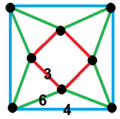 |
|
| 94 | truncated tetrahedral-square |
(1) (3444) |
(1) (488) |
(1) (366) |
(2) (468) |
 |
|
| [64] | ( rectified order-4 octahedral (rocth) |
(3434) |
(4444) |
(3434) |
(3434) |
 |
 |
| [65] | ( order-4 octahedral (octh) |
(3333) |
- | (3333) |
(3333) |
 | |
| [67] | ( truncated order-4 octahedral (tocth) |
(466) |
(4444) |
(3434) |
(466) |
 |
 |
| [83] | alternated square ( |
(444) |
(4444) |
- | (444) |
(4.3.4.3) |
|
| [84] | cantic square ( |
(388) |
(488) |
(3434) |
(388) |
 |
|
| [85] | runcic square ( |
(3444) |
(3434) |
(3333) |
(3444) |
 |
|
| [86] | runcicantic square ( |
(468) |
(488) |
(466) |
(468) |
 |
|
Close
More information #, Honeycomb name Coxeter diagram ...
| # | Honeycomb name Coxeter diagram |
Cells by location | Vertex figure | Picture | ||||
|---|---|---|---|---|---|---|---|---|
| 0 |
1 |
2 |
3 |
Alt | ||||
| Scaliform | snub order-4 octahedral | - | - | irr. {}v{4} | ||||
| Nonuniform | ||||||||
| 155 | alternated tetrahedral-square | r{4,3} | ||||||
Close
[(4,4,4,3)] family
There are 9 forms, generated by ring permutations of the Coxeter group: ![]()
![]()
![]()
![]() .
.
More information #, Honeycomb name Coxeter diagram ...
| # | Honeycomb name Coxeter diagram |
Cells by location (and count around each vertex) |
Vertex figure | Picture | |||
|---|---|---|---|---|---|---|---|
| 0 |
1 |
2 |
3 | ||||
| 95 | cubic-square |
(8) (4.4.4) |
- | (6) (4.4.4.4) |
(12) (4.4.4.4) |
(3.4.4.4) |
|
| 96 | octahedral-square |
(3.4.3.4) |
(3.3.3.3) |
- | (4.4.4.4) |
(4.4.4.4) |
|
| 97 | cyclotruncated cubic-square |
(4) (3.8.8) |
(1) (3.3.3.3) |
(1) (4.4.4.4) |
(4) (4.8.8) |
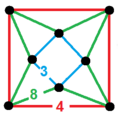 |
|
| 98 | cyclotruncated square-cubic |
(1) (4.4.4) |
(1) (4.4.4) |
(3) (4.8.8) |
(3) (4.8.8) |
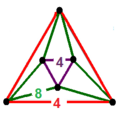 |
|
| 99 | cyclotruncated octahedral-square |
(4) (4.6.6) |
(4) (4.6.6) |
(1) (4.4.4.4) |
(1) (4.4.4.4) |
 |
|
| 100 | rectified cubic-square |
(1) (3.4.3.4) |
(2) (3.4.4.4) |
(1) (4.4.4.4) |
(2) (4.4.4.4) |
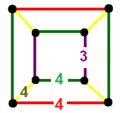 |
|
| 101 | truncated cubic-square |
(1) (4.8.8) |
(1) (3.4.4.4) |
(2) (4.8.8) |
(1) (4.8.8) |
 |
|
| 102 | truncated octahedral-square |
(2) (4.6.8 |
(1) (4.6.6) |
(1) (4.4.4.4) |
(1) (4.8.8) |
 |
|
| 103 | omnitruncated octahedral-square |
(1) (4.6.8) |
(1) (4.6.8) |
(1) (4.8.8) |
(1) (4.8.8) |
 |
|
Close
More information #, Honeycomb name Coxeter diagram ...
| # | Honeycomb name Coxeter diagram |
Cells by location (and count around each vertex) |
Vertex figure | ||||
|---|---|---|---|---|---|---|---|
| 0 |
1 |
2 |
3 |
Alt | |||
| 156 | alternated cubic-square |
- | (3.4.4.4) |
||||
| Nonuniform | snub octahedral-square |
||||||
| Nonuniform | cyclosnub square-cubic |
||||||
| Nonuniform | cyclosnub octahedral-square |
||||||
| Nonuniform | omnisnub cubic-square |
(3.3.3.3.4) |
(3.3.3.3.4) |
(3.3.4.3.4) |
(3.3.4.3.4) |
+(3.3.3) |
|
Close
[(4,4,4,4)] family
There are 5 forms, 1 unique, generated by ring permutations of the Coxeter group: ![]()
![]()
![]()
![]()
![]() . Repeat constructions are related as:
. Repeat constructions are related as: ![]()
![]()
![]()
![]()
![]() ↔
↔ ![]()
![]()
![]()
![]()
![]() ,
, ![]()
![]()
![]()
![]()
![]() ↔
↔ ![]()
![]()
![]()
![]()
![]()
![]()
![]() , and
, and ![]()
![]()
![]()
![]()
![]() ↔
↔ ![]()
![]()
![]()
![]() .
.
More information #, Honeycomb name Coxeter diagram ...
| # | Honeycomb name Coxeter diagram |
Cells by location (and count around each vertex) |
Vertex figure | Picture | |||
|---|---|---|---|---|---|---|---|
| 0 |
1 |
2 |
3 | ||||
| 104 | quarter order-4 square |
(4.8.8) |
(4.4.4.4) |
(4.4.4.4) |
(4.8.8) |
 |
|
| [62] | square (squah) |
(4.4.4.4) |
(4.4.4.4) |
(4.4.4.4) |
(4.4.4.4) |
 |
 |
| [77] | order-4 square (sisquah) ( |
(4.4.4.4) |
- | (4.4.4.4) |
(4.4.4.4) |
(4.4.4.4) |
 |
| [78] | truncated order-4 square (tissish) ( |
(4.8.8) |
(4.4.4.4) |
(4.8.8) |
(4.8.8) |
 |
 |
| [79] | bitruncated order-4 square (dish) |
(4.8.8) |
(4.8.8) |
(4.8.8) |
(4.8.8) |
 |
 |
Close
More information #, Honeycomb name Coxeter diagram ...
| # | Honeycomb name Coxeter diagram |
Cells by location (and count around each vertex) |
Vertex figure | ||||
|---|---|---|---|---|---|---|---|
| 0 |
1 |
2 |
3 |
Alt | |||
| [83] | alternated square ( |
(6) (4.4.4.4) |
(6) (4.4.4.4) |
(6) (4.4.4.4) |
(6) (4.4.4.4) |
(8) (4.4.4) |
(4.3.4.3) |
| [77] | alternated order-4 square (sisquah) |
- | |||||
| 158 | cantic order-4 square |
||||||
| Nonuniform | cyclosnub square |
||||||
| Nonuniform | snub order-4 square |
||||||
| Nonuniform | bisnub order-4 square |
(3.3.4.3.4) |
(3.3.4.3.4) |
(3.3.4.3.4) |
(3.3.4.3.4) |
+(3.3.3) |
 |
Close
[(6,3,3,3)] family
There are 9 forms, generated by ring permutations of the Coxeter group: ![]()
![]()
![]()
![]() .
.
More information #, Honeycomb name Coxeter diagram ...
| # | Honeycomb name Coxeter diagram |
Cells by location (and count around each vertex) |
Vertex figure | |||
|---|---|---|---|---|---|---|
| 0 |
1 |
2 |
3 | |||
| 105 | tetrahedral-hexagonal |
(4) (3.3.3) |
- | (4) (6.6.6) |
(6) (3.6.3.6) |
(3.4.3.4) |
| 106 | tetrahedral-triangular |
(3.3.3.3) |
(3.3.3) |
- | (3.3.3.3.3.3) |
(3.4.6.4) |
| 107 | cyclotruncated tetrahedral-hexagonal |
(3) (3.6.6) |
(1) (3.3.3) |
(1) (6.6.6) |
(3) (6.6.6) |
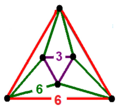 |
| 108 | cyclotruncated hexagonal-tetrahedral |
(1) (3.3.3) |
(1) (3.3.3) |
(4) (3.12.12) |
(4) (3.12.12) |
 |
| 109 | cyclotruncated tetrahedral-triangular |
(6) (3.6.6) |
(6) (3.6.6) |
(1) (3.3.3.3.3.3) |
(1) (3.3.3.3.3.3) |
 |
| 110 | rectified tetrahedral-hexagonal |
(1) (3.3.3.3) |
(2) (3.4.3.4) |
(1) (3.6.3.6) |
(2) (3.4.6.4) |
 |
| 111 | truncated tetrahedral-hexagonal |
(1) (3.6.6) |
(1) (3.4.3.4) |
(1) (3.12.12) |
(2) (4.6.12) |
 |
| 112 | truncated tetrahedral-triangular |
(2) (4.6.6) |
(1) (3.6.6) |
(1) (3.4.6.4) |
(1) (6.6.6) |
 |
| 113 | omnitruncated tetrahedral-hexagonal |
(1) (4.6.6) |
(1) (4.6.6) |
(1) (4.6.12) |
(1) (4.6.12) |
 |
Close
More information #, Honeycomb name Coxeter diagram ...
| # | Honeycomb name Coxeter diagram |
Cells by location (and count around each vertex) |
Vertex figure | ||||
|---|---|---|---|---|---|---|---|
| 0 |
1 |
2 |
3 |
Alt | |||
| Nonuniform | omnisnub tetrahedral-hexagonal |
(3.3.3.3.3) |
(3.3.3.3.3) |
(3.3.3.3.6) |
(3.3.3.3.6) |
+(3.3.3) |
 |
Close
[(6,3,4,3)] family
There are 9 forms, generated by ring permutations of the Coxeter group: ![]()
![]()
![]()
![]()
![]()
More information #, Honeycomb name Coxeter diagram ...
| # | Honeycomb name Coxeter diagram |
Cells by location (and count around each vertex) |
Vertex figure | |||
|---|---|---|---|---|---|---|
| 0 |
1 |
2 |
3 | |||
| 114 | octahedral-hexagonal |
(6) (3.3.3.3) |
- | (8) (6.6.6) |
(12) (3.6.3.6) |
 |
| 115 | cubic-triangular |
(∞) (3.4.3.4) |
(∞) (4.4.4) |
- | (∞) (3.3.3.3.3.3) |
(3.4.6.4) |
| 116 | cyclotruncated octahedral-hexagonal |
(3) (4.6.6) |
(1) (4.4.4) |
(1) (6.6.6) |
(3) (6.6.6) |
 |
| 117 | cyclotruncated hexagonal-octahedral |
(1) (3.3.3.3) |
(1) (3.3.3.3) |
(4) (3.12.12) |
(4) (3.12.12) |
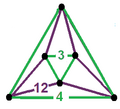 |
| 118 | cyclotruncated cubic-triangular |
(6) (3.8.8) |
(6) (3.8.8) |
(1) (3.3.3.3.3.3) |
(1) (3.3.3.3.3.3) |
 |
| 119 | rectified octahedral-hexagonal |
(1) (3.4.3.4) |
(2) (3.4.4.4) |
(1) (3.6.3.6) |
(2) (3.4.6.4) |
 |
| 120 | truncated octahedral-hexagonal |
(1) (4.6.6) |
(1) (3.4.4.4) |
(1) (3.12.12) |
(2) (4.6.12) |
 |
| 121 | truncated cubic-triangular |
(2) (4.6.8) |
(1) (3.8.8) |
(1) (3.4.6.4) |
(1) (6.6.6) |
 |
| 122 | omnitruncated octahedral-hexagonal |
(1) (4.6.8) |
(1) (4.6.8) |
(1) (4.6.12) |
(1) (4.6.12) |
 |
Close
More information #, Honeycomb name Coxeter diagram ...
| # | Honeycomb name Coxeter diagram |
Cells by location (and count around each vertex) |
Vertex figure | ||||
|---|---|---|---|---|---|---|---|
| 0 |
1 |
2 |
3 |
Alt | |||
| Nonuniform | cyclosnub octahedral-hexagonal |
(3.3.3.3.3) |
(3.3.3) |
(3.3.3.3.3.3) |
(3.3.3.3.3.3) |
irr. {3,4} |
 |
| Nonuniform | omnisnub octahedral-hexagonal |
(3.3.3.3.4) |
(3.3.3.3.4) |
(3.3.3.3.6) |
(3.3.3.3.6) |
irr. {3,3} |
 |
Close
[(6,3,5,3)] family
There are 9 forms, generated by ring permutations of the Coxeter group: ![]()
![]()
![]()
![]()
![]()
More information #, Honeycomb name Coxeter diagram ...
| # | Honeycomb name Coxeter diagram |
Cells by location (and count around each vertex) |
Vertex figure | Picture | |||
|---|---|---|---|---|---|---|---|
| 0 |
1 |
2 |
3 | ||||
| 123 | icosahedral-hexagonal |
(6) (3.3.3.3.3) |
- | (8) (6.6.6) |
(12) (3.6.3.6) |
 3.4.5.4 |
|
| 124 | dodecahedral-triangular |
(30) (3.5.3.5) |
(20) (5.5.5) |
- | (12) (3.3.3.3.3.3) |
 (3.4.6.4) |
|
| 125 | cyclotruncated icosahedral-hexagonal |
(3) (5.6.6) |
(1) (5.5.5) |
(1) (6.6.6) |
(3) (6.6.6) |
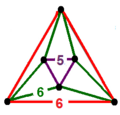 |
|
| 126 | cyclotruncated hexagonal-icosahedral |
(1) (3.3.3.3.3) |
(1) (3.3.3.3.3) |
(5) (3.12.12) |
(5) (3.12.12) |
 |
|
| 127 | cyclotruncated dodecahedral-triangular |
(6) (3.10.10) |
(6) (3.10.10) |
(1) (3.3.3.3.3.3) |
(1) (3.3.3.3.3.3) |
 |
|
| 128 | rectified icosahedral-hexagonal |
(1) (3.5.3.5) |
(2) (3.4.5.4) |
(1) (3.6.3.6) |
(2) (3.4.6.4) |
 |
|
| 129 | truncated icosahedral-hexagonal |
(1) (5.6.6) |
(1) (3.5.5.5) |
(1) (3.12.12) |
(2) (4.6.12) |
 |
|
| 130 | truncated dodecahedral-triangular |
(2) (4.6.10) |
(1) (3.10.10) |
(1) (3.4.6.4) |
(1) (6.6.6) |
 |
|
| 131 | omnitruncated icosahedral-hexagonal |
(1) (4.6.10) |
(1) (4.6.10) |
(1) (4.6.12) |
(1) (4.6.12) |
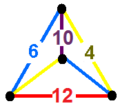 |
|
Close
More information #, Honeycomb name Coxeter diagram ...
| # | Honeycomb name Coxeter diagram |
Cells by location (and count around each vertex) |
Vertex figure | Picture | ||||
|---|---|---|---|---|---|---|---|---|
| 0 |
1 |
2 |
3 |
Alt | ||||
| Nonuniform | omnisnub icosahedral-hexagonal |
 (3.3.3.3.5) |
 (3.3.3.3.5) |
(3.3.3.3.6) |
(3.3.3.3.6) |
 +(3.3.3) |
 |
|
Close
[(6,3,6,3)] family
There are 6 forms, generated by ring permutations of the Coxeter group: ![]()
![]()
![]()
![]()
![]() .
.
More information #, Honeycomb name Coxeter diagram ...
| # | Honeycomb name Coxeter diagram |
Cells by location (and count around each vertex) |
Vertex figure | Picture | |||
|---|---|---|---|---|---|---|---|
| 0 |
1 |
2 |
3 | ||||
| 132 | hexagonal-triangular |
(3.3.3.3.3.3) |
- | (6.6.6) |
(3.6.3.6) |
(3.4.6.4) |
|
| 133 | cyclotruncated hexagonal-triangular |
(1) (3.3.3.3.3.3) |
(1) (3.3.3.3.3.3) |
(3) (3.12.12) |
(3) (3.12.12) |
 |
|
| 134 | cyclotruncated triangular-hexagonal |
(1) (3.6.3.6) |
(2) (3.4.6.4) |
(1) (3.6.3.6) |
(2) (3.4.6.4) |
 |
|
| 135 | rectified hexagonal-triangular |
(1) (6.6.6) |
(1) (3.4.6.4) |
(1) (3.12.12) |
(2) (4.6.12) |
 |
|
| 136 | truncated hexagonal-triangular |
(1) (4.6.12) |
(1) (4.6.12) |
(1) (4.6.12) |
(1) (4.6.12) |
 |
|
| [16] | order-4 hexagonal tiling (shexah) = |
(3) (6.6.6) |
(1) (6.6.6) |
(1) (6.6.6) |
(3) (6.6.6) |
 (3.3.3.3) |
 |
Close
More information #, Honeycomb name Coxeter diagram ...
| # | Honeycomb name Coxeter diagram |
Cells by location (and count around each vertex) |
Vertex figure | Picture | ||||
|---|---|---|---|---|---|---|---|---|
| 0 |
1 |
2 |
3 |
Alt | ||||
| [141] | alternated order-4 hexagonal (ashexah) |
(3.3.3.3.3.3) |
(3.3.3.3.3.3) |
(3.3.3.3.3.3) |
(3.3.3.3.3.3) |
+(3.3.3.3) |
(4.6.6) |
|
| Nonuniform | cyclocantisnub hexagonal-triangular |
|||||||
| Nonuniform | cycloruncicantisnub hexagonal-triangular |
|||||||
| Nonuniform | snub rectified hexagonal-triangular |
(3.3.3.3.6) |
(3.3.3.3.6) |
(3.3.3.3.6) |
(3.3.3.3.6) |
+(3.3.3) |
 |
|
Close
Remove ads
Loop-n-tail graphs
Summarize
Perspective
[3,3[3]] family
There are 11 forms, 4 unique, generated by ring permutations of the Coxeter group: [3,3[3]] or ![]()
![]()
![]()
![]()
![]() . 7 are half symmetry forms of [3,3,6]:
. 7 are half symmetry forms of [3,3,6]: ![]()
![]()
![]()
![]()
![]() ↔
↔ ![]()
![]()
![]()
![]()
![]()
![]()
![]() .
.
More information #, Honeycomb name Coxeter diagram ...
Close
More information #, Honeycomb name Coxeter diagram ...
| # | Honeycomb name Coxeter diagram |
Cells by location (and count around each vertex) |
vertex figure | ||||
|---|---|---|---|---|---|---|---|
| 0 |
1 |
0' |
3 |
Alt | |||
| Nonuniform | snub rectified order-6 tetrahedral |
(3.3.3.3.3) |
(3.3.3.3) |
(3.3.3.3.3) |
(3.3.3.3.3.3) |
+(3.3.3) |
 |
Close
[4,3[3]] family
There are 11 forms, 4 unique, generated by ring permutations of the Coxeter group: [4,3[3]] or ![]()
![]()
![]()
![]()
![]() . 7 are half symmetry forms of [4,3,6]:
. 7 are half symmetry forms of [4,3,6]: ![]()
![]()
![]()
![]()
![]() ↔
↔ ![]()
![]()
![]()
![]()
![]()
![]()
![]() .
.
More information #, Honeycomb name Coxeter diagram ...
Close
More information #, Honeycomb name Coxeter diagram ...
| # | Honeycomb name Coxeter diagram |
Cells by location (and count around each vertex) |
vertex figure | ||||
|---|---|---|---|---|---|---|---|
| 0 |
1 |
0' |
3 |
Alt | |||
| Nonuniform | snub rectified order-4 hexagonal |
(3.3.3.3.4) |
(3.3.3.3) |
(3.3.3.3.4) |
(3.3.3.3.3.3) |
+(3.3.3) |
|
Close
[5,3[3]] family
There are 11 forms, 4 unique, generated by ring permutations of the Coxeter group: [5,3[3]] or ![]()
![]()
![]()
![]()
![]() . 7 are half symmetry forms of [5,3,6]:
. 7 are half symmetry forms of [5,3,6]: ![]()
![]()
![]()
![]()
![]() ↔
↔ ![]()
![]()
![]()
![]()
![]()
![]()
![]() .
.
More information #, Honeycomb name Coxeter diagram ...
Close
More information #, Honeycomb name Coxeter diagram ...
| # | Honeycomb name Coxeter diagram |
Cells by location (and count around each vertex) |
vertex figure | Picture | ||||
|---|---|---|---|---|---|---|---|---|
| 0 |
1 |
0' |
3 |
Alt | ||||
| Nonuniform | snub rectified order-5 hexagonal |
(3.3.3.3.5) |
(3.3.3) |
(3.3.3.3.5) |
(3.3.3.3.3.3) |
+(3.3.3) |
||
Close
[6,3[3]] family
There are 11 forms, 4 unique, generated by ring permutations of the Coxeter group: [6,3[3]] or ![]()
![]()
![]()
![]()
![]() . 7 are half symmetry forms of [6,3,6]:
. 7 are half symmetry forms of [6,3,6]: ![]()
![]()
![]()
![]()
![]() ↔
↔ ![]()
![]()
![]()
![]()
![]()
![]()
![]() .
.
More information #, Honeycomb name Coxeter diagram ...
Close
More information #, Honeycomb name Coxeter diagram ...
| # | Honeycomb name Coxeter diagram |
Cells by location (and count around each vertex) |
vertex figure | Picture | ||||
|---|---|---|---|---|---|---|---|---|
| 0 |
1 |
0' |
3 |
Alt | ||||
| [54] | triangular tiling honeycomb (trah) ( |
- | - | (6.6.6) |
 | |||
| [137] | alternated hexagonal (ahexah) ( |
- | +(3.6.6) |
(3.6.6) |
||||
| [47] | rectified order-6 hexagonal (rihihexah) |
(3.6.3.6) |
- | (3.6.3.6) |
(3.3.3.3.3.3) |
 |
 | |
| [55] | cantic order-6 hexagonal (ritrah) ( |
(1) (3.6.3.6) |
- | (2) (6.6.6) |
(2) (3.6.3.6) |
 |
 | |
| Nonuniform | snub rectified order-6 hexagonal |
(3.3.3.3.6) |
(3.3.3.3) |
(3.3.3.3.6) |
(3.3.3.3.3.3) |
+(3.3.3) |
||
Close
Remove ads
Multicyclic graphs
Summarize
Perspective
[3[ ]×[ ]] family
There are 8 forms, 1 unique, generated by ring permutations of the Coxeter group: ![]()
![]()
![]()
![]()
![]() . Two are duplicated as
. Two are duplicated as ![]()
![]()
![]()
![]()
![]() ↔
↔ ![]()
![]()
![]()
![]()
![]() , two as
, two as ![]()
![]()
![]()
![]()
![]() ↔
↔ ![]()
![]()
![]()
![]()
![]() , and three as
, and three as ![]()
![]()
![]()
![]()
![]() ↔
↔ ![]()
![]()
![]()
![]()
![]()
![]()
![]() .
.
More information #, Honeycomb name Coxeter diagram ...
| # | Honeycomb name Coxeter diagram |
Cells by location (and count around each vertex) |
Vertex figure | Picture | |||
|---|---|---|---|---|---|---|---|
| 0 |
1 |
2 |
3 | ||||
| 151 | Quarter order-4 hexagonal (quishexah) |
 |
|||||
| [17] | rectified order-4 hexagonal (rishexah) |
 (4.4.4) |
 | ||||
| [18] | rectified order-6 cubic (rihach) |
 (6.4.4) |
 | ||||
| [21] | bitruncated order-6 cubic (chexah) |
 |
 | ||||
| [87] | alternated order-6 cubic (ahach) |
- | (3.6.3.6) |
||||
| [88] | cantic order-6 cubic (tachach) |
||||||
| [141] | alternated order-4 hexagonal (ashexah) |
- | (4.6.6) |
||||
| [142] | cantic order-4 hexagonal (tashexah) |
 |
|||||
Close
More information #, Honeycomb name Coxeter diagram ...
| # | Honeycomb name Coxeter diagram |
Cells by location (and count around each vertex) |
Vertex figure | Picture | ||||
|---|---|---|---|---|---|---|---|---|
| 0 |
1 |
2 |
3 |
Alt | ||||
| Nonuniform | bisnub order-6 cubic |
irr. {3,3} |
 |
|||||
Close
[3[3,3]] family
There are 4 forms, 0 unique, generated by ring permutations of the Coxeter group: ![]()
![]()
![]() . They are repeated in four families:
. They are repeated in four families: ![]()
![]()
![]()
![]()
![]() ↔
↔ ![]()
![]()
![]()
![]()
![]() (index 2 subgroup),
(index 2 subgroup),
![]()
![]()
![]()
![]()
![]() ↔
↔ ![]()
![]()
![]()
![]()
![]()
![]()
![]() (index 4 subgroup),
(index 4 subgroup),
![]()
![]()
![]()
![]()
![]() ↔
↔ ![]()
![]()
![]()
![]()
![]()
![]()
![]() (index 6 subgroup), and
(index 6 subgroup), and
![]()
![]()
![]() ↔
↔ ![]()
![]()
![]()
![]()
![]()
![]()
![]() (index 24 subgroup).
(index 24 subgroup).
More information #, Name Coxeter diagram ...
| # | Name Coxeter diagram |
0 | 1 | 2 | 3 | vertex figure | Picture |
|---|---|---|---|---|---|---|---|
| [1] | hexagonal (hexah) |
 {3,3} |
 | ||||
| [47] | rectified order-6 hexagonal (rihihexah) |
 t{2,3} |
 | ||||
| [54] | triangular tiling honeycomb (trah) ( |
- | t{3[3]} |
 | |||
| [55] | rectified triangular (ritrah) |
 t{2,3} |
 |
Close
More information #, Name Coxeter diagram ...
| # | Name Coxeter diagram |
0 | 1 | 2 | 3 | Alt | vertex figure | Picture |
|---|---|---|---|---|---|---|---|---|
| [137] | alternated hexagonal (ahexah) ( |
s{3[3]} |
s{3[3]} |
s{3[3]} |
s{3[3]} |
{3,3} |
(4.6.6) |
Close
Remove ads
Summary enumerations by family
Summarize
Perspective
Linear graphs
More information  ,
,  ...
...
 ,
,  ...
...| Group | Extended symmetry |
Honeycombs | Chiral extended symmetry |
Alternation honeycombs | ||
|---|---|---|---|---|---|---|
 [4,4,3] |
[4,4,3] | 15 | [1+,4,1+,4,3+] | (6) | ||
| [4,4,3]+ | (1) | |||||
 [4,4,4] |
[4,4,4] | 3 | [1+,4,1+,4,1+,4,1+] | (3) | ||
| [4,4,4] |
(3) | [1+,4,1+,4,1+,4,1+] | (3) | |||
| [2+[4,4,4]] | 3 | [2+[(4,4+,4,2+)]] | (2) | |||
| [2+[4,4,4]]+ | (1) | |||||
 [6,3,3] |
[6,3,3] | 15 | [1+,6,(3,3)+] | (2) | ||
| [6,3,3]+ | (1) | |||||
 [6,3,4] |
[6,3,4] | 15 | [1+,6,3+,4,1+] | (6) | ||
| [6,3,4]+ | (1) | |||||
 [6,3,5] |
[6,3,5] | 15 | [1+,6,(3,5)+] | (2) | ||
| [6,3,5]+ | (1) | |||||
 [3,6,3] |
[3,6,3] | 5 | ||||
| [3,6,3] | (1) | [2+[3+,6,3+]] | (1) | |||
| [2+[3,6,3]] | 3 | [2+[3,6,3]]+ | (1) | |||
 [6,3,6] |
[6,3,6] | 6 | [1+,6,3+,6,1+] | (2) | ||
| [2+[6,3,6]] | (1) | [2+[(6,3+,6,2+)]] | (2) | |||
| [2+[6,3,6]] | 2 | |||||
| [2+[6,3,6]]+ | (1) | |||||
Close
Tridental graphs
More information  ,
,  ...
...
 ,
,  ...
...| Group | Extended symmetry |
Honeycombs | Chiral extended symmetry |
Alternation honeycombs | ||
|---|---|---|---|---|---|---|
 [6,31,1] | [6,31,1] | 4 | ||||
| [1[6,31,1]]=[6,3,4] | (7) | [1[1+,6,31,1]]+ | (2) | |||
| [1[6,31,1]]+=[6,3,4]+ | (1) | |||||
 [3,41,1] | [3,41,1] | 4 | [3+,41,1]+ | (2) | ||
| [1[3,41,1]]=[3,4,4] | (7) | [1[3+,41,1]]+ | (2) | |||
| [1[3,41,1]]+ | (1) | |||||
 [41,1,1] | [41,1,1] | 0 | (none) | |||
| [1[41,1,1]]=[4,4,4] | (4) | [1[1+,4,1+,41,1]]+=[(4,1+,4,1+,4,2+)] | (4) | |||
| [3[41,1,1]]=[4,4,3] | (3) | [3[1+,41,1,1]]+=[1+,4,1+,4,3+] | (2) | |||
| [3[41,1,1]]+=[4,4,3]+ | (1) | |||||
Close
Cyclic graphs
More information  ,
,  ...
...
 ,
,  ...
...| Group | Extended symmetry |
Honeycombs | Chiral extended symmetry |
Alternation honeycombs | ||
|---|---|---|---|---|---|---|
 [(4,4,4,3)] |
[(4,4,4,3)] | 6 | [(4,1+,4,1+,4,3+)] | (2) | ||
| [2+[(4,4,4,3)]] | 3 | [2+[(4,4+,4,3+)]] | (2) | |||
| [2+[(4,4,4,3)]]+ | (1) | |||||
 [4[4]] |
[4[4]] | (none) | ||||
| [2+[4[4]]] | 1 | [2+[(4+,4)[2]]] | (1) | |||
| [1[4[4]]]=[4,41,1] | (2) | [(1+,4)[4]] | (2) | |||
| [2[4[4]]]=[4,4,4] | (1) | [2+[(1+,4,4)[2]]] | (1) | |||
| [(2+,4)[4[4]]]=[2+[4,4,4]] | (1) | [(2+,4)[4[4]]]+ = [2+[4,4,4]]+ |
(1) | |||
 [(6,3,3,3)] |
[(6,3,3,3)] | 6 | ||||
| [2+[(6,3,3,3)]] | 3 | [2+[(6,3,3,3)]]+ | (1) | |||
 [(3,4,3,6)] |
[(3,4,3,6)] | 6 | [(3+,4,3+,6)] | (1) | ||
| [2+[(3,4,3,6)]] | 3 | [2+[(3,4,3,6)]]+ | (1) | |||
 [(3,5,3,6)] |
[(3,5,3,6)] | 6 | ||||
| [2+[(3,5,3,6)]] | 3 | [2+[(3,5,3,6)]]+ | (1) | |||
 [(3,6)[2]] |
[(3,6)[2]] | 2 | ||||
| [2+[(3,6)[2]]] | 1 | |||||
| [2+[(3,6)[2]]] | 1 | |||||
| [2+[(3,6)[2]]] | (1) | [2+[(3+,6)[2]]] | (1) | |||
| [(2,2)+[(3,6)[2]]] | 1 | [(2,2)+[(3,6)[2]]]+ | (1) | |||
Close
More information  ,
,  ...
...
 ,
,  ...
...| Group | Extended symmetry |
Honeycombs | Chiral extended symmetry |
Alternation honeycombs | ||
|---|---|---|---|---|---|---|
 [(3,3,4,4)] |
[(3,3,4,4)] | 4 | ||||
| [1[(4,4,3,3)]]=[3,41,1] | (7) | [1[(3,3,4,1+,4)]]+ = [3+,41,1]+ | (2) | |||
| [1[(3,3,4,4)]]+ = [3,41,1]+ | (1) | |||||
 [3[ ]x[ ]] |
[3[ ]x[ ]] | 1 | ||||
| [1[3[ ]x[ ]]]=[6,31,1] | (2) | |||||
| [1[3[ ]x[ ]]]=[4,3[3]] | (2) | |||||
| [2[3[ ]x[ ]]]=[6,3,4] | (3) | [2[3[ ]x[ ]]]+ =[6,3,4]+ | (1) | |||
 [3[3,3]] |
[3[3,3]] | 0 | (none) | |||
| [1[3[3,3]]]=[6,3[3]] | 0 | (none) | ||||
| [3[3[3,3]]]=[3,6,3] | (2) | |||||
| [2[3[3,3]]]=[6,3,6] | (1) | |||||
| [(3,3)[3[3,3]]]=[6,3,3] | (1) | [(3,3)[3[3,3]]]+ = [6,3,3]+ | (1) | |||
Close
Loop-n-tail graphs
Symmetry in these graphs can be doubled by adding a mirror: [1[n,3[3]]] = [n,3,6]. Therefore ring-symmetry graphs are repeated in the linear graph families.
More information  ,
,  ...
...
 ,
,  ...
...| Group | Extended symmetry |
Honeycombs | Chiral extended symmetry |
Alternation honeycombs | ||
|---|---|---|---|---|---|---|
 [3,3[3]] | [3,3[3]] | 4 | ||||
| [1[3,3[3]]]=[3,3,6] | (7) | [1[3,3[3]]]+ = [3,3,6]+ | (1) | |||
 [4,3[3]] | [4,3[3]] | 4 | ||||
| [1[4,3[3]]]=[4,3,6] | (7) | [1+,4,(3[3])+] | (2) | |||
| [4,3[3]]+ | (1) | |||||
 [5,3[3]] | [5,3[3]] | 4 | ||||
| [1[5,3[3]]]=[5,3,6] | (7) | [1[5,3[3]]]+ = [5,3,6]+ | (1) | |||
 [6,3[3]] | [6,3[3]] | 2 | ||||
| [6,3[3]] = | (2) | ( |
||||
| [(3,3)[1+,6,3[3]]]=[6,3,3] | (1) | [(3,3)[1+,6,3[3]]]+ | (1) | |||
| [1[6,3[3]]]=[6,3,6] | (6) | [3[1+,6,3[3]]]+ = [3,6,3]+ | (1) | |||
| [1[6,3[3]]]+ = [6,3,6]+ | (1) | |||||
Close
Remove ads
See also
Notes
References
Wikiwand - on
Seamless Wikipedia browsing. On steroids.
Remove ads
Remove ads
